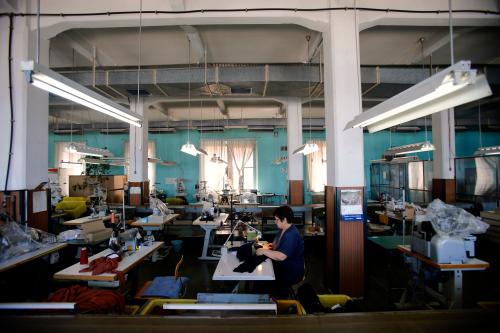The Western Balkans is suffering from high labor taxes, and the low-wage earners are taking the brunt of it. This unfortunate trap is a result of a combination of the Bismarckian social insurance legacy of socialist Yugoslavia and a flat-tax revolution that swept the region in the early 2000s. The trap is most pronounced in Bosnia and Herzegovina, Montenegro, Serbia, and a little less so in North Macedonia. In these countries, a low-wage, high-tax trap translates into comparatively fewer incentives to work (at least in the formal sector) for low-skill workers, and, on the side of employers, into fewer incentives to hire low-wage workers and to invest in labor-intensive low-wage sectors. And this, in turn, leads to lower employment and activity rates, higher informal work, and higher inequality in disposable wages and income.
The key measure of the labor tax burden across countries is the labor tax wedge. It is calculated as the ratio of the total labor taxes (income tax and employee contributions combined) paid by and on behalf of a worker, and the total cost of a worker to the firm, which, in addition to labor taxes, includes take-home wage of the worker. Comparing labor tax wedges across countries is not easy because, in modern tax jurisdictions, tax schedules are typically different across individual workers, depending on their place in the wage distribution and on their family situation. Often, a shortcut is used, and the tax wedge for a hypothetical single worker earning the exact average wage is used for comparisons of the labor tax burden across countries. This popular approach tends to grossly underestimate the overall burden of labor taxes in Western Balkan economies.
In a new report “Western Balkans Labor Market Trends 2019,” Dragan Aleksic and I have taken a more comprehensive approach. Our research reconfirms that labor tax wedges in the Western Balkans are higher for workers with below-average earnings because labor tax progressivity is lower than in most EU or OECD countries. These workers make up around two-thirds of total employment—such is the typical skewness of wage distribution. In addition, most EU and OECD countries have family tax credits for workers with dependents. In Western Balkan countries, these tax credits do not exist or are much less generous. As a result, at the same tax wedges for hypothetical workers in the EU and the Western Balkans, the true tax burden faced by an average worker (either in cross-section or over a worker’s lifetime) is higher in the Western Balkans.
Low progressivity means that low-wage workers do not earn much in terms of net take-home pay, but are still relatively costly to firms. When the headline labor taxes are low, as in Kosovo and Albania, this is tolerable. When these taxes are high, as in Montenegro, Bosnia and Herzegovina, and Serbia, this becomes quite burdensome, not only for low-wage workers but also for firms and sectors relying on low-wage, low- or medium-skill labor. In Figure 1, we see that tax wedges for minimum wage workers (on the vertical axis) in the Western Balkans are as high as anywhere in Europe (area with highest tax wedges globally). On the vertical axis of Figure 1, a difference (in percentage points) between the tax wedge at the minimum wage and at the average wage is presented.
Figure 1. Western Balkans—boxed in the corner
 Note: Western Balkan countries, marked by red circles, have high tax wedges at minimum wage (except Albania and Kosovo) and low progressivity between minimum and average wage
Note: Western Balkan countries, marked by red circles, have high tax wedges at minimum wage (except Albania and Kosovo) and low progressivity between minimum and average wage
To illuminate the economic consequences of a high tax wedge for low-wage workers, let us look at Montenegro and the Czech Republic. In both countries, the net minimum wage is around 40 percent of that of an average-wage worker. Yet the cost to a firm of hiring a minimum-wage worker in the Czech Republic is just 30 percent of the cost of hiring an average wage worker, compared to 40 percent in Montenegro. If relative net wages reflect the productivity of workers, Montenegrin firms employing low-wage workers are at a clear competitive disadvantage compared with Czech firms. If relative labor costs reflect that productivity, then Montenegrin low-wage workers are paid below their relative productivity—or pushed into informality. In reality, for those who manage to remain in the formal sector, this excess tax burden is shared between low-wage workers and their employers. In relative comparison with their more fortunate Czech counterparts, Montenegrin low-wage workers are underpaid, and Montenegrin employers in low-wage sectors are overtaxed.






Commentary
A low-wage, high-tax trap in the Western Balkans
March 22, 2019